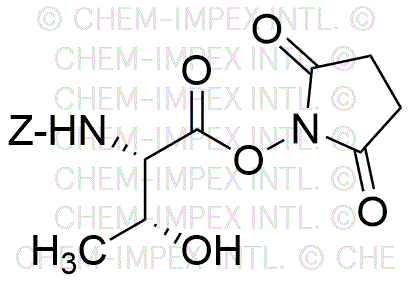Z-L-threonine N-hydroxysuccinimide ester is widely utilized in research focused on:
- Peptide Synthesis: This compound serves as a valuable building block in the synthesis of peptides, allowing researchers to create complex molecules for drug development and biological studies.
- Bioconjugation: It is often used in bioconjugation techniques, where it helps attach biomolecules to surfaces or other molecules, enhancing the functionality of diagnostic tools and therapeutic agents.
- Drug Delivery Systems: The ester form aids in the development of drug delivery systems, improving the solubility and stability of pharmaceutical compounds, which is crucial for effective treatment.
- Research in Protein Engineering: This compound is instrumental in protein engineering, enabling scientists to modify proteins for better performance in therapeutic applications or industrial processes.
- Development of Antibody-Drug Conjugates: It plays a key role in the creation of antibody-drug conjugates, which are designed for targeted cancer therapies, providing a more effective treatment option with reduced side effects.
General Information
Properties
Safety and Regulations
Applications
Z-L-threonine N-hydroxysuccinimide ester is widely utilized in research focused on:
- Peptide Synthesis: This compound serves as a valuable building block in the synthesis of peptides, allowing researchers to create complex molecules for drug development and biological studies.
- Bioconjugation: It is often used in bioconjugation techniques, where it helps attach biomolecules to surfaces or other molecules, enhancing the functionality of diagnostic tools and therapeutic agents.
- Drug Delivery Systems: The ester form aids in the development of drug delivery systems, improving the solubility and stability of pharmaceutical compounds, which is crucial for effective treatment.
- Research in Protein Engineering: This compound is instrumental in protein engineering, enabling scientists to modify proteins for better performance in therapeutic applications or industrial processes.
- Development of Antibody-Drug Conjugates: It plays a key role in the creation of antibody-drug conjugates, which are designed for targeted cancer therapies, providing a more effective treatment option with reduced side effects.
Documents
Safety Data Sheets (SDS)
The SDS provides comprehensive safety information on handling, storage, and disposal of the product.
Product Specification (PS)
The PS provides a comprehensive breakdown of the product’s properties, including chemical composition, physical state, purity, and storage requirements. It also details acceptable quality ranges and the product's intended applications.
Certificates of Analysis (COA)
Search for Certificates of Analysis (COA) by entering the products Lot Number. Lot and Batch Numbers can be found on a product’s label following the words ‘Lot’ or ‘Batch’.
Numéro de catalogue
Numéro de lot/série
Certificates Of Origin (COO)
This COO confirms the country where the product was manufactured, and also details the materials and components used in it and whether it is derived from natural, synthetic, or other specific sources. This certificate may be required for customs, trade, and regulatory compliance.
Numéro de catalogue
Numéro de lot/série
Safety Data Sheets (SDS)
The SDS provides comprehensive safety information on handling, storage, and disposal of the product.
DownloadProduct Specification (PS)
The PS provides a comprehensive breakdown of the product’s properties, including chemical composition, physical state, purity, and storage requirements. It also details acceptable quality ranges and the product's intended applications.
DownloadCertificates of Analysis (COA)
Search for Certificates of Analysis (COA) by entering the products Lot Number. Lot and Batch Numbers can be found on a product’s label following the words ‘Lot’ or ‘Batch’.
Numéro de catalogue
Numéro de lot/série
Certificates Of Origin (COO)
This COO confirms the country where the product was manufactured, and also details the materials and components used in it and whether it is derived from natural, synthetic, or other specific sources. This certificate may be required for customs, trade, and regulatory compliance.


